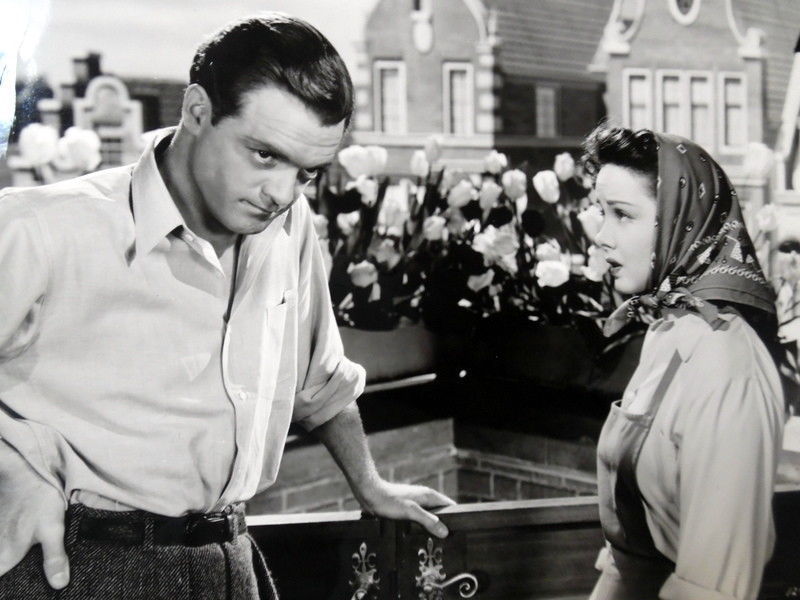Happy Birthday, Van Heflin!
“Louis B. Mayer once looked at me and said, ‘You will never get the girl at the end,’” recalled actor Van Heflin once in an interview. “So I worked on my acting.” The man born Emmett Evan Heflin, Jr. in Walters, Oklahoma on this date in 1908 (some sources report 1910) always boasted, “I’ve never played the same part twice. I’m a character actor—always have been.” You’d be hard pressed to find a finer character thesp; Heflin not only gave memorable performances in such (highly recommended) films as Act of Violence (1949) and The Prowler (1951)…he got the last laugh on Mayer when he was awarded a Best Supporting Actor Oscar in 1943 for his turn as Robert Taylor’s alcoholic buddy in Johnny Eager (1942).
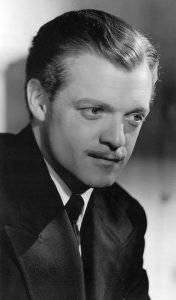 The son of Fanny Bleecker and Emmett Evan Heflin, Sr. (a dentist by profession), Van, Jr. had an interest in acting since his childhood. (This interest was shared by his sister, [Mary] Frances Heflin—known to TV daytime drama fans as Mona Kane Tyler on All My Children). Schooled in Oklahoma in his early years, Van would relocate to California when his parents went their separate ways. Having graduated, he answered the siren song of the sea by shipping out on a tramp steamer for a year of nautical adventure. Heflin would return to The Sooner State to attend the University of Oklahoma in pursuit of a law degree…but eventually turned his attention to performing. Van would later graduate from Yale University with a master’s degree in theater.
The son of Fanny Bleecker and Emmett Evan Heflin, Sr. (a dentist by profession), Van, Jr. had an interest in acting since his childhood. (This interest was shared by his sister, [Mary] Frances Heflin—known to TV daytime drama fans as Mona Kane Tyler on All My Children). Schooled in Oklahoma in his early years, Van would relocate to California when his parents went their separate ways. Having graduated, he answered the siren song of the sea by shipping out on a tramp steamer for a year of nautical adventure. Heflin would return to The Sooner State to attend the University of Oklahoma in pursuit of a law degree…but eventually turned his attention to performing. Van would later graduate from Yale University with a master’s degree in theater.
In the late 1920s, Van Heflin was already making a name for himself as a stage actor with appearances in productions like Mister Moneypenny (1928). Heflin returned to stage work after taking another sailing sabbatical (he had a passion for sea spray and salt air that would last his lifetime) for three years, landing roles in plays like The Bride of Torozko (1934) and Mid-West (1936). A plum showcase in 1936’s End of Summer got him noticed in Hollywood, and Van made his prestigious motion picture debut opposite Katharine Hepburn in A Woman Rebels (1936). That assignment won him a contract with RKO, where he graced such programmers as The Outcasts of Poker Flat, Flight from Glory, Annapolis Salute, and Saturday’s Heroes (all of which were released in 1937). Other movie triumphs included Back Door to Heaven (1939) and Santa Fe Trail (1940).
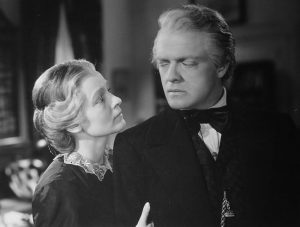 Katharine Hepburn was so impressed with Van Heflin from A Woman Rebels that she insisted he be cast as “Macaulay ‘Mike’ Connor” opposite her “Tracy Lord” in the Broadway stage smash The Philadelphia Story (1939). Sadly, Van lost out to James Stewart when Philadelphia was adapted for the screen the following year (a role that won Jimmy a Best Actor Oscar), but he wasn’t left completely empty-handed. Heflin got an MGM contract out of it, and the studio put him to work in such features as The Feminine Touch (1941), H.M. Pulham, Esq. (1941), and the aforementioned Johnny Eager. (Heflin also appeared in a pair of the studio’s “B” pictures, 1942’s Kid Glove Killer and Grand Central Murder.) For a time, MGM seemed interested in turning the actor into a leading man in films like Tennessee Johnson (1942), Seven Sweethearts (1942), and Presenting Lily Mars (1943). With World War II in progress, the actor decided to “do his bit” by enlisting in the Army, serving as a combat cameraman with the Motion Picture Unit and also the Ninth Air Force in Europe.
Katharine Hepburn was so impressed with Van Heflin from A Woman Rebels that she insisted he be cast as “Macaulay ‘Mike’ Connor” opposite her “Tracy Lord” in the Broadway stage smash The Philadelphia Story (1939). Sadly, Van lost out to James Stewart when Philadelphia was adapted for the screen the following year (a role that won Jimmy a Best Actor Oscar), but he wasn’t left completely empty-handed. Heflin got an MGM contract out of it, and the studio put him to work in such features as The Feminine Touch (1941), H.M. Pulham, Esq. (1941), and the aforementioned Johnny Eager. (Heflin also appeared in a pair of the studio’s “B” pictures, 1942’s Kid Glove Killer and Grand Central Murder.) For a time, MGM seemed interested in turning the actor into a leading man in films like Tennessee Johnson (1942), Seven Sweethearts (1942), and Presenting Lily Mars (1943). With World War II in progress, the actor decided to “do his bit” by enlisting in the Army, serving as a combat cameraman with the Motion Picture Unit and also the Ninth Air Force in Europe.
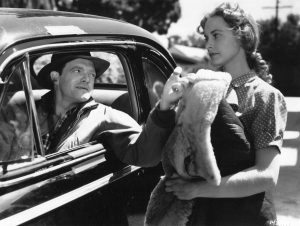 Van Heflin returned to motion pictures in 1946 with one of his most accessible films (it’s fallen into the public domain), The Strange Love of Martha Ivers (1946; with Barbara Stanwyck), and he followed that “film noir” turn with another trip to Dark City in 1947’s Possessed (with Joan Crawford). This period in Heflin’s movie career saw him not only as a serviceable leading man, but a most versatile actor – demonstrating a range between Green Dolphin Street (1947) and The Three Musketeers (1948) to Madame Bovary (1949) and East Side, West Side (1949). Many of his movie performances would be reprised on radio’s popular anthology series, including The Lux Radio Theatre and The Theatre Guild on the Air.
Van Heflin returned to motion pictures in 1946 with one of his most accessible films (it’s fallen into the public domain), The Strange Love of Martha Ivers (1946; with Barbara Stanwyck), and he followed that “film noir” turn with another trip to Dark City in 1947’s Possessed (with Joan Crawford). This period in Heflin’s movie career saw him not only as a serviceable leading man, but a most versatile actor – demonstrating a range between Green Dolphin Street (1947) and The Three Musketeers (1948) to Madame Bovary (1949) and East Side, West Side (1949). Many of his movie performances would be reprised on radio’s popular anthology series, including The Lux Radio Theatre and The Theatre Guild on the Air.
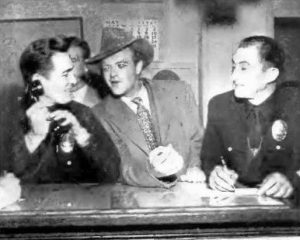 You see, Van Heflin was well acquainted with performing in front of a radio microphone. In his Broadway days, the actor supplemented his stage work on radio soaps like Betty and Bob and Way Down East. An inventory check of Heflin’s on-air resume would include appearances on such popular shows as Escape and Suspense, not to mention Arch Oboler’s Plays, The Cavalcade of America, The Columbia Workshop, The Doctor Fights, Family Theatre, The Ford Theatre, Hallmark Playhouse, The Lady Esther Screen Guild Theatre, The Man Called X (Heflin filled in for star Herbert Marshall on a May 25, 1951 broadcast), The NBC University Theatre, and The Radio Reader’s Digest. Van’s most high-profile gig was being the first to star in a weekly radio series as Raymond Chandler’s famed sleuth on The Adventures of Philip Marlowe, which was a summer replacement series for Bob Hope’s Pepsodent show in 1947. (Heflin would guest on Bob’s show when the comedian resumed in the fall and was also one of the guest stars on a notorious Sealtest Variety Theatre broadcast [March 4, 1949] that was plagued with technical problems [and a little unplanned profanity].)
You see, Van Heflin was well acquainted with performing in front of a radio microphone. In his Broadway days, the actor supplemented his stage work on radio soaps like Betty and Bob and Way Down East. An inventory check of Heflin’s on-air resume would include appearances on such popular shows as Escape and Suspense, not to mention Arch Oboler’s Plays, The Cavalcade of America, The Columbia Workshop, The Doctor Fights, Family Theatre, The Ford Theatre, Hallmark Playhouse, The Lady Esther Screen Guild Theatre, The Man Called X (Heflin filled in for star Herbert Marshall on a May 25, 1951 broadcast), The NBC University Theatre, and The Radio Reader’s Digest. Van’s most high-profile gig was being the first to star in a weekly radio series as Raymond Chandler’s famed sleuth on The Adventures of Philip Marlowe, which was a summer replacement series for Bob Hope’s Pepsodent show in 1947. (Heflin would guest on Bob’s show when the comedian resumed in the fall and was also one of the guest stars on a notorious Sealtest Variety Theatre broadcast [March 4, 1949] that was plagued with technical problems [and a little unplanned profanity].)
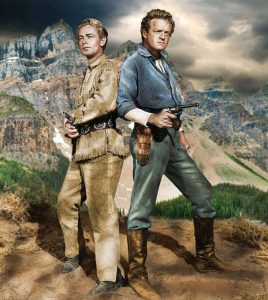 By the 1950s, Van Heflin was starting to explore acting opportunities on the small screen, with guest appearances on TV shows like Robert Montgomery Presents and Playhouse 90. His motion picture output never slacked off, however; his well-known feature films at this point in his career include My Son John (1952), Wings of the Hawk (1953), The Raid (1954), Battle Cry (1955), and Patterns (1956). Heflin’s best remembered film would be released in 1953: Shane. In this Western classic, Van was in danger of losing his wife (played by Jean Arthur) to a handsome gunman-turned-drifter (Alan Ladd). Heflin further demonstrated his flair for the sagebrush with appearances in oaters like 3:10 to Yuma (1957—my favorite of his films), Gunman’s Walk (1958), and They Came to Cordura (1959).
By the 1950s, Van Heflin was starting to explore acting opportunities on the small screen, with guest appearances on TV shows like Robert Montgomery Presents and Playhouse 90. His motion picture output never slacked off, however; his well-known feature films at this point in his career include My Son John (1952), Wings of the Hawk (1953), The Raid (1954), Battle Cry (1955), and Patterns (1956). Heflin’s best remembered film would be released in 1953: Shane. In this Western classic, Van was in danger of losing his wife (played by Jean Arthur) to a handsome gunman-turned-drifter (Alan Ladd). Heflin further demonstrated his flair for the sagebrush with appearances in oaters like 3:10 to Yuma (1957—my favorite of his films), Gunman’s Walk (1958), and They Came to Cordura (1959).
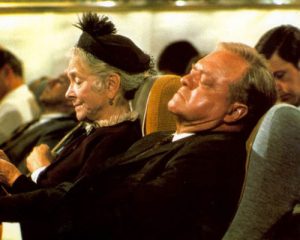 Van Heflin returned to Broadway for one last turn amongst the footlights with the very well-received A Case of Libel in 1963. (When he reprised this role for a TV version in 1968, he received an Emmy nomination for Outstanding Single Performance in a Drama.) Throughout the decade, Heflin continued to work in films like Cry of Battle (1963) and Stagecoach (1966), and while it wasn’t his final show business turn (he did two TV movies in 1970 and 1971), he made a memorable impression in the all-star disaster drama Airport (1970) as the sympathetic but nevertheless twisted antagonist whose on-board bomb sets the film’s plot in motion. Van would succumb to a heart attack in 1971 (while he was enjoying a dip in his pool), and per his request, his ashes would be scattered in the Pacific, so he could continue his love for the sea.
Van Heflin returned to Broadway for one last turn amongst the footlights with the very well-received A Case of Libel in 1963. (When he reprised this role for a TV version in 1968, he received an Emmy nomination for Outstanding Single Performance in a Drama.) Throughout the decade, Heflin continued to work in films like Cry of Battle (1963) and Stagecoach (1966), and while it wasn’t his final show business turn (he did two TV movies in 1970 and 1971), he made a memorable impression in the all-star disaster drama Airport (1970) as the sympathetic but nevertheless twisted antagonist whose on-board bomb sets the film’s plot in motion. Van would succumb to a heart attack in 1971 (while he was enjoying a dip in his pool), and per his request, his ashes would be scattered in the Pacific, so he could continue his love for the sea.
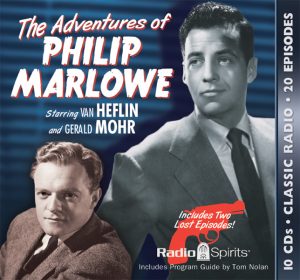 Van Heflin’s producer on Airport, Ross Hunter, remarked after the actor’s passing: “I’ve never known a kinder, simpler, more understanding man. People didn’t realize this—his talent overshadowed it all.” Radio Spirits extends the warmest of invitations on Van’s birthday to check out both his talent and his signature radio role on our Adventures of Philip Marlowe collection (with the five surviving Heflin broadcasts supplemented by shows featuring Gerald Mohr). In addition, you can hear Heflin in the “Wild Oranges” broadcast (09/28/49) on Escape to the High Seas, and “The Lady in the Red Hat” (11/30/50) on Suspense: Wages of Sin. Happy birthday, Mr. Heflin!
Van Heflin’s producer on Airport, Ross Hunter, remarked after the actor’s passing: “I’ve never known a kinder, simpler, more understanding man. People didn’t realize this—his talent overshadowed it all.” Radio Spirits extends the warmest of invitations on Van’s birthday to check out both his talent and his signature radio role on our Adventures of Philip Marlowe collection (with the five surviving Heflin broadcasts supplemented by shows featuring Gerald Mohr). In addition, you can hear Heflin in the “Wild Oranges” broadcast (09/28/49) on Escape to the High Seas, and “The Lady in the Red Hat” (11/30/50) on Suspense: Wages of Sin. Happy birthday, Mr. Heflin!

